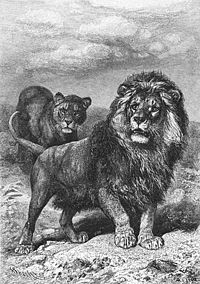Panthera leo melanochaitus
The Cape lion or black lion (Panthera leo melanochaitus) is a subpopulation of the African lion. now extinct southern species, which lived on the grassy plains of the Karoo, southwest of South Africa. The Dutch (Boer) colonizers are often blamed for their extinction. However, the real people responsible for their extermination were the English; when at the beginning of the 19th century they definitively took over the Dutch colony; and they began to hunt it indiscriminately for sport and in retaliation for its attacks on livestock, until exterminating it in the mid-1860s.
The Cape subspecies was the largest of those that originally inhabited present-day South African territory (the other, the South African lion, survives today). There are no records of the actual weight of these lions, however it is estimated that the largest males weighed up to 250 kg. The females were somewhat smaller, but still stout, probably reaching 150 kg in weight, like today's South African lionesses. Due to the colder and drier climate, lions in Cape Province had less prey than those in other places, so they were less abundant and did not form prides, but rather led a solitary life as opportunistic predators. The males had a dense black mane that partially extended across the belly, similar to that of the Asian subspecies and especially that of the Atlas or Berber. However, it could be easily differentiated from it by its proportionally shorter legs and straighter mane. Like the babies of other lions, the cubs of this subspecies were born covered in spots that disappeared with the development of the animal. This was faster than normal among lions, so the mane began to grow when the males were still very young.

When the first settlers arrived in the 17th century, lions attacked practically anything, whether it was a zebra, an antelope or even a seal that was resting on the beach. They soon saw domestic animals, and their owners, as easy prey, especially if attacked at night. The stories from this time abound with testimonies about large lions that came to try to scale the palisades of European settlements. Jan van Riebeeck, who founded Cape Town in 1652, had to build the Castle of Good Hope precisely to prevent its attacks. Around 1666, the primitive wooden structure began to be replaced by another stone structure that would make its defense more effective.
The Cape lion disappeared so quickly after contact with Europeans that habitat destruction is unlikely to be a major factor. Hunting, both for sport and to protect the settlements and flocks of the Dutch and English Europeans, reduced the distribution of this subspecies. The last lion in the province of Cape Town was killed in 1858, and the subspecies became permanently extinct when a certain General Bisset hunted the last recorded specimen in Natal in 1865. The gradual elimination by European settlers of the herds of zebra, antelope, buffalo and giraffe that constituted their most important food source also contributed to their extinction.
Recently, South African John Spence undertook a campaign to search for possible descendants of Cape lions that had been brought to Europe and kept in captivity before they became extinct in the wild. In 2001 he thought he found them in a small family of lions that live in the Novosibirsk Zoological Garden, in the heart of Siberia. Nobody knows the exact origin of these lions, since they arrived at the zoo after being abandoned by a circus. Thanks to Spence's efforts, two cubs from this group—unusually large for their age, even compared to others in the same zoo—were sent to Tygerberg Zoo in Cape Town. Future DNA studies will determine whether they are indeed the last Cape lions on earth, or at least some of their descendants partially hybridized with other subspecies of lions.
Contenido relacionado
Jean Théodore Delacour
Rhincodon typus
Bryozoa